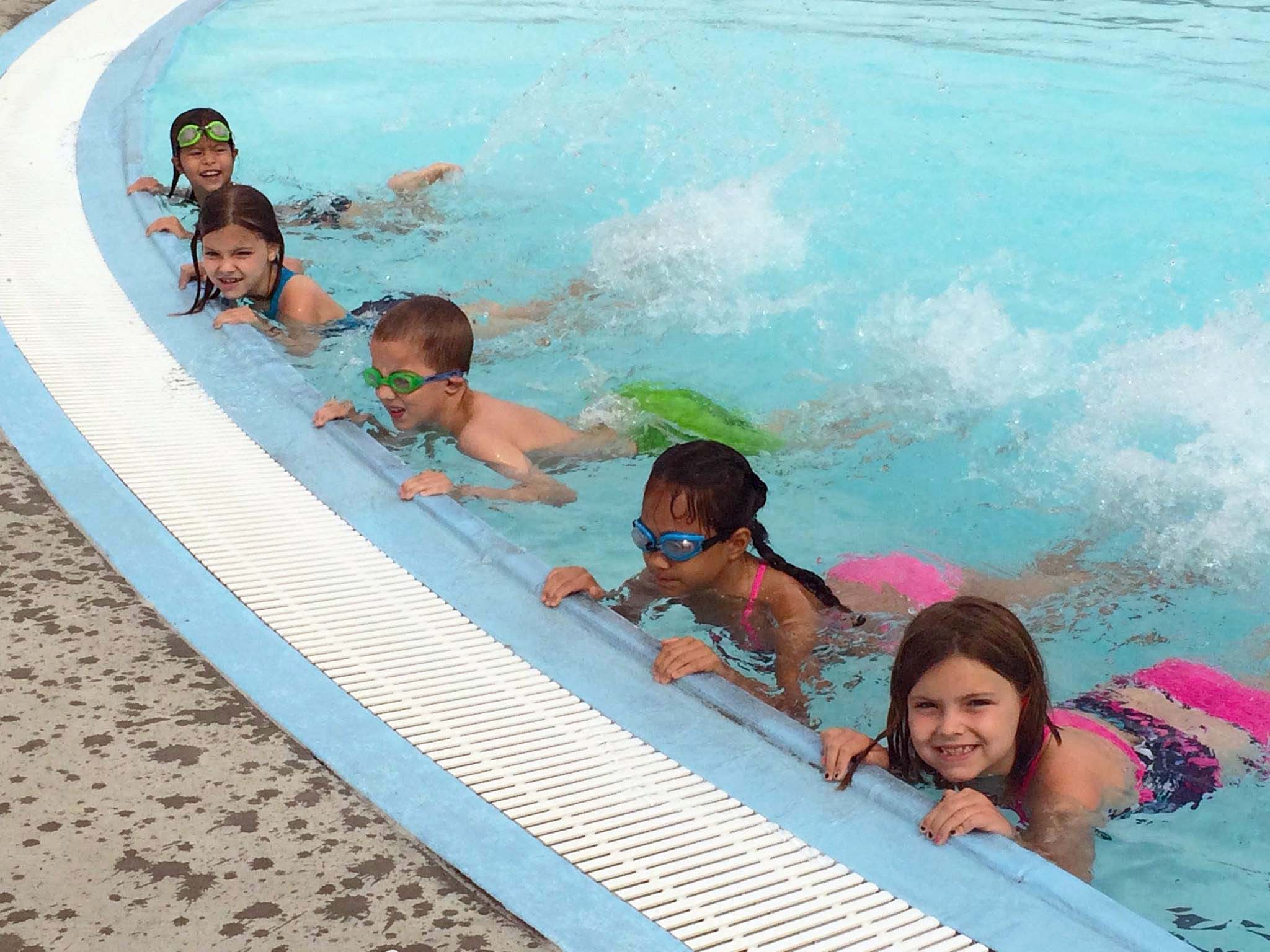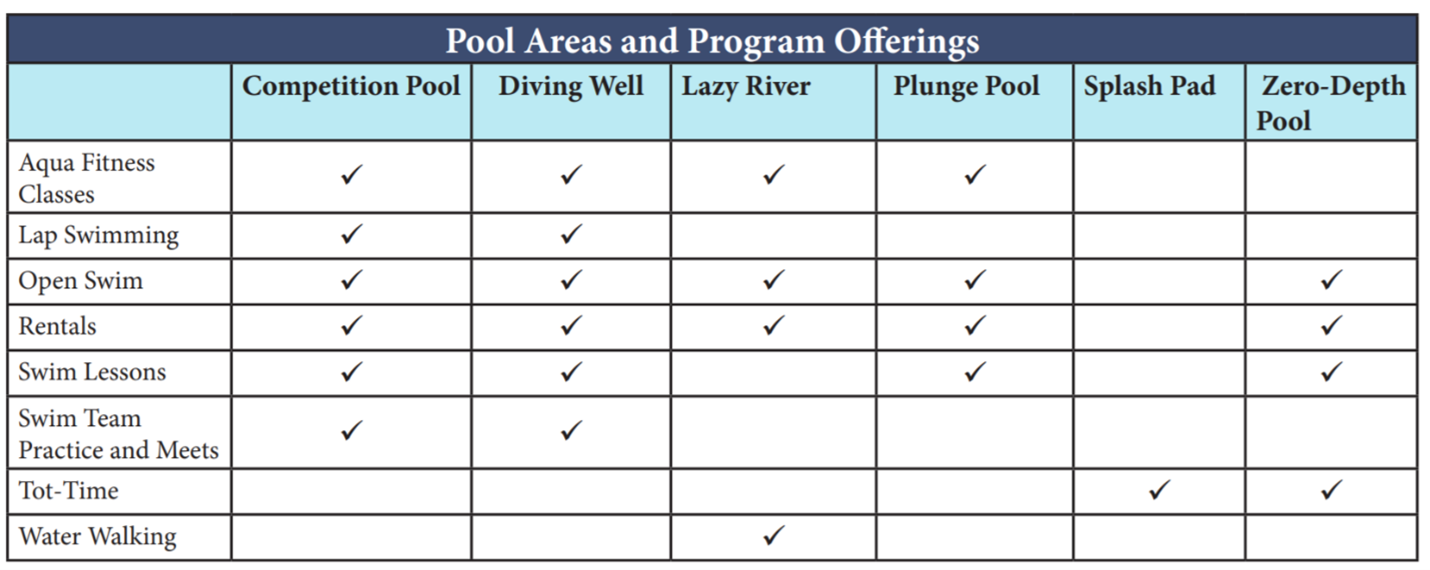All eyes are on 2021 as the come-back year post the COVID-19 pandemic in 2020. Although there is still the unknown about what our communities will look like in the summer of 2021, planning for opening pool facilities is what the wintertime is made for. This year is no exception.
After months of becoming accustomed to distancing, modified business practices, a sharp decline in public spaces, large group gatherings, and finding new ways to recreate – summer swimming in 2021 may take on a new look and feel. Although different than years past, there is an opportunity to shift our aquatic perspective to align more with how users may want to utilize pool facilities moving forward.
With a societal shift comes a door that can be opened to reevaluate how we offer services and a subsequent adaptation to that shift. Pools have evolved from public baths and watering holes, to modern aquatic centers over time, because of societal shifts in who visits and how public swimming facilities are utilized. Who visits and how they utilize pool facilities in the wake of the pandemic may also evolve into something a little different. This opportunity for a modification in how pool facilities operate brings with it new possibilities for evaluation and positive change.
Programming Trends and the Future
For well over half a year, people have become reacquainted with the outdoors as indoor gatherings were restricted and eliminated. Outdoor recreational activities skyrocketed and with it, water sports such as kayaking and stand-up paddle boarding became even more popular. People who never participated in a water activity suddenly became interested, and stores across the United States could not keep recreational equipment on their shelves. The forced distancing may have changed how people view recreational water and outdoor activities; incorporating this renewed interest into an operation could be a way forward.
Pools will always have their committed visitors and those who will buy that pool membership every year. However, 2020 has taught us something new. We now know that people who may not have shown interest in a water activity previously are open to the idea in a world post-COVID. Many people have developed a reclaimed perspective on what “recreation” means to them. With this renewed appreciation for leisure activities, we can focus on how to capture their interest in water through pools. Rethinking how to and who can utilize the clean, controlled, and available spaces can increase usability and create a dynamic and active pool.
The typical pool day of offering general open swim from noon to 8 p.m. (or a close variation of that) has long been the standard pool schedule for the outdoor municipal pool. In 2020, open facilities offered variations of this schedule that were unique to that community. For example, a facility may have offered staggered swim times so that fewer participants swam at a given time, but multiple swim times were offered. The benefit behind this system was not only could distancing occur more easily, but agencies were able to study use patterns throughout the day and identify when users were most interested in swimming. Deck chairs were more available and there was not the overwhelming influx of participants in the middle of the day, a situation that is beneficial for the bottom line but not a desired situation of membership holders. Although this sign up structure may not work every day for typical use, this concept could be applied to programs or times in which staff are limited. Special event swim sessions like morning family swim time or adult sunbathing could be activities to consider.

Additionally, inclusive swimming became more of a focus in 2020 as explorations of exclusively requiring pool passes or daily admissions occurred. However, not everyone can afford a pool pass or to pay for family admission multiple times a season. An option to accommodate this is to open swimming activities to more users by offering a pre-set number of admissions per day or times of day that are reduced cost, and requiring pre-registration like the adjusted 2020 schedule example mentioned above.
Traditional programs, such as swim lessons and swim team, saw modifications in 2020 that may have applicability to future seasons as well. Having guardians physically assist the swimmer during swim lesson classes would reduce contact with the instructor and possibly increase the number of participants in the class. In doing so this could also teach the assisting adults swimming skills that are beneficial to them as well as proper steps to instruct the child outside of the class setting. Recording lessons, tips and tricks, and sharing those online are additional methods of educating about water safety, while also expanding the knowledge base of the community.
Swim team, as a team sport, implies that team members will participate in the activity together. Utilizing technology allows for communication from the coach to the swimmers in the water, providing quick and effective coaching. This can occur while also maintaining necessary distancing. Small group swim clinics or swim clubs provide continued one-on-one development with potentially more distancing opportunities. These solutions are not to take the place of team sports and coaching, but rather enhance the athlete’s educational opportunities and take safety into account.
Incorporating local trends and successes can reinvigorate the facility and keep it exciting to both loyal users and new users alike. How can pools reimagine how the spaces are utilized?
-
-
- Kayakers could learn barrel rolls as a new safety technique in the slide catch pool
- New fishermen and fisherwomen could learn to cast or fly-fish in waders in the lap pool.
- A science class could be taught utilizing pump room and exposed piping at the splashpad.
- Membership only swims with pre-registration may reduce the number of patrons at a time and possibly the number of staff, all while promoting pool memberships.
-
Recreation is unique in that creativity is valued and there is an understanding that each person may require or be interested in a variety of different activities. Pool facilities are no exception. They can be reimagined even in the slightest of ways, allowing for an evolution from typical or traditional use.
Operational Planning
Developing an operational business plan for an existing facility assists in creating and utilizing efficient and multi-functional spaces. As a part of that plan, conducting a facility inventory of the available spaces and how and when they are utilized can help identify potential opportunities for increased offerings.
If there is a space, time, or demographic that is possibly underserved – narrow down the missing need and focus on that solution. For example, a facility may identify that there is an unused time between swim team in the morning and open swim at noon, with available staff already at the facility. Feedback has been received that families with younger swimmers have a desire to swim earlier in the day to avoid the heat of mid-day, and adults have expressed interest in visiting before the daycares arrive. In this scenario, it could be an opportunity to offer a toddler swim, lap swim, members only swim, or an adult swim/sunbathing time during this open spot between swim team and open swim. Interestingly, as Waters Edge Aquatic Design plan a new project and talk with community members, we often hear that adults would like some fun in the sun during adult times. These times can vary either in the morning or in the evening while the kids may not typically be at the pool. This is an example of identifying a vacancy in the schedule and targeting activities to increase participation from demographics that may currently be underserved.
To understand where the schedule is full and where the vacancies are, a good place to start is by developing a space inventory. In this exercise the goal is to identify the different pool spaces at the facility while also identifying which programs utilize the space. Doing so will help point out which areas of the facility are available and can be targeted when creating new activities. The location, the depth, surrounding amenities, and overall functionality of the space all will play into what type of activity can be offered in that area.
To demonstrate this exercise, a sample “Pool Space Inventory” is shown below. In this sample, the Splash Pad is only utilized for Tot-Time. Other options to utilize this space more regularly are to open it for use for general swim, include it in the rental package, and possibly host special events, such as an inclusive event or an introductory class for swim lessons to teach water exploration.
Sample Pool Space Inventory

To continue the facility inventory, developing a schedule inventory is the second step after studying how the spaces are utilized. By taking inventory of the spaces by hour and by day, opportunities in the schedule will be identified and a comparison of the activities running at a given time can be easily conducted. If there is a day or time of day that has availability, new activities can be explored that fit with the staffing needs already in place and that encourage increased participation.
The sample “Pool Schedule Inventory” below is an example of this exercise. It is broken down by the days of the week that have similar and varying schedules. In this case, the pool schedule is the same Monday – Thursday, with a different schedule on Friday, also Saturday – Sunday. “Closed” on the schedule means there is no activity being offered at that time and the space is available for use. In this example, Friday mornings are relatively available, with swim team being the only activity offered which occur in the lap lanes. The splash down area is currently not being used and could be opened for a self-guided fitness workouts or private swim lessons. It could also be a good time to offer practice time to kayakers who would like to practice their barrel roles in the plunge pool and swimming against the current in the lazy river.
Sample Pool Schedule Inventory
The goal behind operational planning is to understand what you have, where you perform well, and what areas could be improved. A facility inventory more specifically targets those areas, days, times, and activities that could potentially generate additional use. A more diverse group of participants will be served by offering varied activities and programs. This is important due to the increased interest in recreation and the possibilities of more distanced activities in the future. Flexibility, strategic scheduling, creative use, and focused targeting will assist you as you plan for your new and improved 2021 season.
